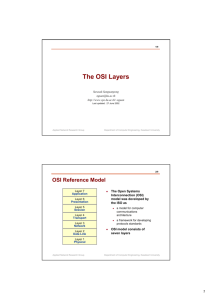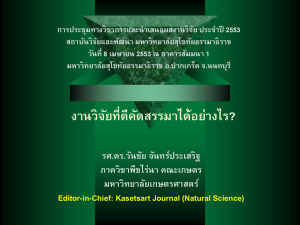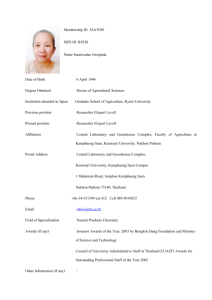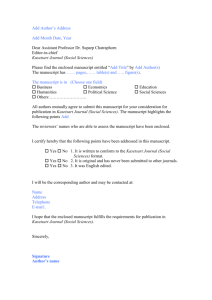Wireless LAN Infrastructure - Department of Computer Engineering
advertisement
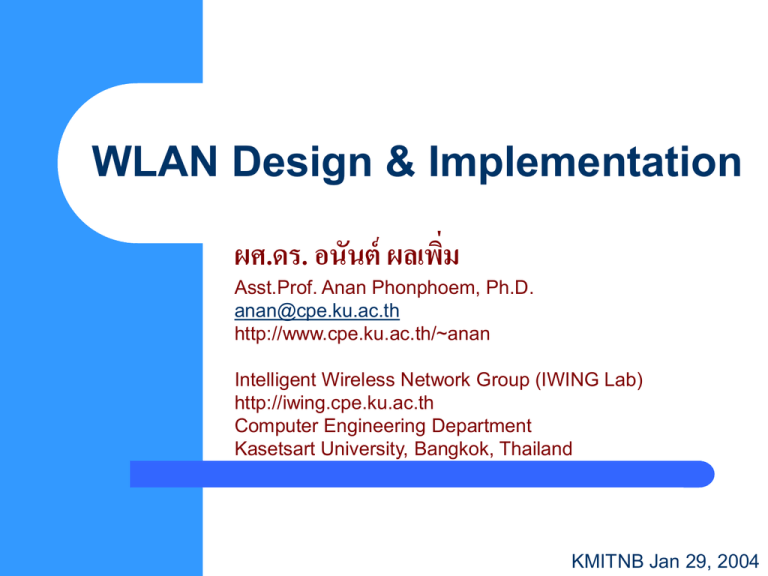
WLAN Design & Implementation ผศ.ดร. อนันต์ ผลเพิม่ Asst.Prof. Anan Phonphoem, Ph.D. anan@cpe.ku.ac.th http://www.cpe.ku.ac.th/~anan Intelligent Wireless Network Group (IWING Lab) http://iwing.cpe.ku.ac.th Computer Engineering Department Kasetsart University, Bangkok, Thailand KMITNB Jan 29, 2004 Outline WLAN Technology Conceptual Review – WLAN Configuration – Management Planning Design & Implementation Phase 2 IWING LAB; Computer Engineering Department; Kasetsart University Wireless System Path Source: Mobile Communications International 3 IWING LAB; Computer Engineering Department; Kasetsart University Wireless Classification WWAN GSM/ GPRS / CDMA WMAN IEEE802.16 WLAN IEEE802.11 HyperLan WPAN Bluetooth WAN WAN-MAN PAN MAN MAN-LAN LAN-PAN Pico-Cell Personal Operating Space ~50km 4 ~2km 0km ~10m Courtesy of IEEE 802.15, Jan. 2001 IWING LAB; Computer Engineering Department; Kasetsart University History and present of IEEE 802.11 5 IWING LAB; Computer Engineering Department; Kasetsart University IEEE 802.11 Family Standards Band (GHz) Raw Throughput 802.11 2.4 2Mbps (Legacy) 6 802.11a 802.11b 802.11g 5 2.4 2.4 54Mbps 11Mbps 54Mbps 802.11n ?? 100 Mbps IWING LAB; Computer Engineering Department; Kasetsart University IEEE 802.11 Family Standards Descriptions 7 802.11c Improves interoperability 802.11d Multiple Regulatory Domains (Improve Roaming; New country) 802.11e Quality of Service (QoS); prioritizing voice or video 802.11f Inter-Access Point Protocol (IAPP) 802.11h Supports measuring and managing the 5-GHz radio signals in 802.11a 802.11i Enhanced Security (repairs WEP weakness) 802.11j Extensions for Japan 802.11k Passing specific radio frequency health and management data to higher-level management apps. IWING LAB; Computer Engineering Department; Kasetsart University History: 802.11 Legacy 8 1997: First standard – Standard name: IEEE 802.11-1997 – Updated: IEEE 802.11-1999 – Starting Point for “Standard-based WLAN” For 2 Mbps: (fallback to 1 Mbps – Noisy): Direct sequence Spread Spectrum (DSSS) modulation For 1-2 Mbps Frequency Hopping Spread Spectrum (FHSS) Both operate in ISM band 2.4 GHz FHSS, DSSS, and infrared medium IWING LAB; Computer Engineering Department; Kasetsart University 802.11b 9 802.11b-1999 Range 50 – 100 m. (depends on obstacles) Omnidirectial antenna Indoor / Outdoor / Point-to-point (high-gain external antennas) Max throughput of 11 Mbit/s (5.5, 2,1 Mbps) Attenuation: Metal, Thick walls, Water, etc. ISM Band 2.4 GHz; DSSS; CSMA/CA 14 overlapping ch. (Different ch.for different countries) – 3 simultaneously ch. (such as 1, 6, and 11) Proprietary speed extension "802.11b+" (22, 33 and 44 Mbit/s) IWING LAB; Computer Engineering Department; Kasetsart University 802.11a 10 2001 (802.11a-1999) Max throughput of 54 Mbps (Normally around 20 Mbps) ISM Band 5 GHz (FCC may open more spectrum) 12 nonoverlapping channels, – 8 dedicated to indoor – 4 to point to point Not widely deployed (US. / Japan) – 802.11b popularity – Less range / More attenuation – Lack of roll back compatibility (now support a,b,and g) – In Europe considering HiperLan2 IWING LAB; Computer Engineering Department; Kasetsart University 802.11g 11 3rd quarter 2003 ISM Band 2.4 GHz Max throughput of 54 Mbps (Net 24.7 Mbps) Fully backwards compatible with 802.11b Dual-band / Tri-mode – supporting a, b, and g – A single wireless card / Access point IWING LAB; Computer Engineering Department; Kasetsart University 802.11 Wi-Fi 12 Specification defined by IEEE (not Compatibity guarantee) A special group, Wi-Fi Alliance – Group of maufacturer – Test compatibility – Guarantees interoperability (by issue Wi-Fi Trademark) – Start with 802.11b Dual band/Tri mode (a, b, or g) – Security standard Wi-Fi Protected Access (WPA) IWING LAB; Computer Engineering Department; Kasetsart University Wireless Hot Spot 13 Public places – Top-rated hotels and restaurants – Colleges / Universities In-building antenna systems to support various wireless technologies (Wi-Fi/cellular) Wireless friendly environmental hot spot – KUWiN (Kasetsart University Wireless Network http://kuwin.ku.ac.th) http://www.wi-fihotspotlist.com/ IWING LAB; Computer Engineering Department; Kasetsart University WLAN Review WLAN Category Wireless LANs (WLAN) – Radio Waves – Infrared Light – Carrier currents (“no new wire”) Wireless Point-to-Point Networks Wireless WANs 15 IWING LAB; Computer Engineering Department; Kasetsart University Radio Based Wireless LANs Advantages – No line of sights – Propagate through obstacles Disadvantages – Interference – Security 16 IWING LAB; Computer Engineering Department; Kasetsart University WLAN Goal Compliment wired LANs (or replace in the near future?) Two main reasons – Increase user mobility & productivity – Increase installation flexibility in difficult cabling situations 17 IWING LAB; Computer Engineering Department; Kasetsart University WLAN Questions Throughput ? Scalability ? Performance ? Best technologies ? Application support ? – client-server / Network programs – Quality-of-service 18 IWING LAB; Computer Engineering Department; Kasetsart University Data rates and Range Source: Proxim 19 IWING LAB; Computer Engineering Department; Kasetsart University WLAN Configurations Independent WLAN Infrastructure WLAN 20 IWING LAB; Computer Engineering Department; Kasetsart University Independent WLAN Ad Hoc Simplest Rapid deployment Peer-to-peer No administration 21 IWING LAB; Computer Engineering Department; Kasetsart University Independent WLAN Single Cell 22 Multiple Cells IWING LAB; Computer Engineering Department; Kasetsart University Independent WLAN Can extended range by using an Access Point (acting as a repeater) 23 IWING LAB; Computer Engineering Department; Kasetsart University Infrastructure WLAN Need an Access Point Connect to the wired LAN Need Infrastructure Need administration 24 IWING LAB; Computer Engineering Department; Kasetsart University Infrastructure WLAN 25 IWING LAB; Computer Engineering Department; Kasetsart University Infrastructure WLAN 26 IWING LAB; Computer Engineering Department; Kasetsart University SOHO Infrastructure WLAN Hub/Switch Access Point Server 27 Computer Printer IWING LAB; Computer Engineering Department; Kasetsart University (Large) Infrastructure WLAN Internet LAN Hub/Switch Router Hub/Switch LAN 28 IWING LAB; Computer Engineering Department; Kasetsart University Simple WLAN Management Internet LAN Hub/Switch Router Hub/Switch LAN 29 IWING LAB; Computer Engineering Department; Kasetsart University VLAN Switch Management Internet LAN VLAN Switch Router VLAN Switch LAN 30 IWING LAB; Computer Engineering Department; Kasetsart University AP with VLAN Capability Internet LAN Hub/Switch Router Hub/Switch LAN 31 IWING LAB; Computer Engineering Department; Kasetsart University Mobile IP Internet Router 32 LAN IWING LAB; Computer Engineering Department; Kasetsart University Mobile IP Internet Router Home Agent 33 LAN Foreign Agent IWING LAB; Computer Engineering Department; Kasetsart University WLAN Planning Design Requirements To Keep in mind – Availability – Scalability – Manageability – Interoperability 35 IWING LAB; Computer Engineering Department; Kasetsart University Planning Set Project Management Principles Planning a project Executing the project 36 IWING LAB; Computer Engineering Department; Kasetsart University Set Project Management Principles Clear goal / activities / communications Reduction of risks On time / within budget 37 IWING LAB; Computer Engineering Department; Kasetsart University Cost of Ownership Infrastructure costs Client device costs Monthly costs (Power & Internet Access) Management costs – Training – Downtime costs – Support costs (Troubleshoot + repair) 38 IWING LAB; Computer Engineering Department; Kasetsart University Planning a project 39 Define the project scope Develop a work plan / schedule Identify resources (team/materials) Develop a budget (labor/HW/SW/management) Define project operations (role/standard) Evaluation risks (cause of risks adjust) IWING LAB; Computer Engineering Department; Kasetsart University Executing the project Kick-off meeting (review project plan) Status check Technical meeting Progress report 40 IWING LAB; Computer Engineering Department; Kasetsart University Define WLAN requirements 41 User profile & interface Functional (expected) Application Information Flow Performance (Reliability/Availabilit y/BW/Delay) System Interface Environmental Department support Regulation (RF) Mobility Security Budget Schedule IWING LAB; Computer Engineering Department; Kasetsart University Design & Implementation Phase Implementing a WLAN Design DesignaaWLAN WLAN Prepare for operational support Installation 43 IWING LAB; Computer Engineering Department; Kasetsart University Design & Implementation Cycle Source: Cisco Networking Academy 44 IWING LAB; Computer Engineering Department; Kasetsart University Design Phase Define network elements Select products Site survey Verify the design Document the design Procure components 45 IWING LAB; Computer Engineering Department; Kasetsart University Defining Network Elements 46 Identify the network elements – SW (Application / Communication) – OS – LAN /WAN (media / backbone) – Wireless connection (media / data rate) – Addressing – Network management Determining requirements – Choose standard (mature) technologies IWING LAB; Computer Engineering Department; Kasetsart University Selecting Products Functionality Availability Support Price Standard 47 compliance IWING LAB; Computer Engineering Department; Kasetsart University Site Survey Determine coverage area (Cell) Determine number of cells needed Determine the Access Point location 48 IWING LAB; Computer Engineering Department; Kasetsart University Environmental Consideration 49 Environment characteristics – Completed Open (empty floor, no desk) – Semi-Open (partitioning area) – Closed (Blocked room, high wall) Barriers – RF penetration – Attenuations IWING LAB; Computer Engineering Department; Kasetsart University RF Barriers 50 RF Barrier Attenuation Air minimum Wood Low Partitions Plaster Low Office partitions Synthetic Material Low Office patitions Glass Low Windows Water Medium Damp wood, aquarium Bricks Medium Walls Marble Medium Walls Paper High Paper rolls Concrete High Floors / Walls Very High Desk / partitions / elevator Metal Example IWING LAB; Computer Engineering Department; Kasetsart University Conducting Site Survey Preparation Phase Execution Phase Post survey Phase 51 IWING LAB; Computer Engineering Department; Kasetsart University Preparation Phase Contact the authorized person Blueprint / Floor plan Access point / notebook / wireless card Power cord extension / Walkie-Talkie 52 IWING LAB; Computer Engineering Department; Kasetsart University Execution Phase Verify the blueprint Mark permanent user locations Mark permanent roaming area Identify obstacles / interference sources Identify preliminary of AP Test and Record signal strength of selected locations Adjust AP location 53 IWING LAB; Computer Engineering Department; Kasetsart University Post Survey Phase 54 Documentation – Summarize the updated floor plan – Summarize locations of AP – Summarize / Draw the coverage area – Note on restrictions and sugestions IWING LAB; Computer Engineering Department; Kasetsart University Example Lecture Room 1 Computer Room WC Elv1 Control Elv2 Room Lecture Room 2 55 Lab WC Common room IWING LAB; Computer Engineering Department; Kasetsart University Example 1 3 4 Computer B Room Lecture Room 1 A WC 5 2 11 Elv1 Control 7 Elv2 Room 6 D C Lecture Room 2 8 56 Lab 9 10 WC Common room 12 IWING LAB; Computer Engineering Department; Kasetsart University Signal Status 57 IWING LAB; Computer Engineering Department; Kasetsart University Example AP Pos Com. Quality A Note 1 2 6 B 1 2 3 4 5 C 6 7 8 58 9 10 IWING LAB; Computer Engineering Department; Kasetsart University Example AP Pos Com. Quality A B C 59 1 Poor 2 V.good 6 Fair 1 Poor 2 Poor 3 Good 4 V.good 5 Poor 6 Poor 7 Poor 8 Poor 9 Good 10 Note Near microwave oven IWING LAB; Computer Engineering Department; Kasetsart University V.Good Design Phase Define network elements Select products Site survey Verify the design Document the design Procure components 60 IWING LAB; Computer Engineering Department; Kasetsart University Implementing a WLAN Design a WLAN Prepare for operational support – Training / Helpdesk – Admin / network monitoring Installation 61 IWING LAB; Computer Engineering Department; Kasetsart University Implementing a WLAN Design 62 a WLAN Prepare for operational support Installation – Storage – HW Installation / power outlet – network connection point / wiring – testing IWING LAB; Computer Engineering Department; Kasetsart University Summary Clear Design Goals Get support from all levels Well plan Awareness Design Caution about the implementation Documentation 63 IWING LAB; Computer Engineering Department; Kasetsart University References 64 WLAN course material, Anan Phonphoem, Computer Engineering, Kasetsart University, 2001 Guide to Designing and Implementing Wireless LANs, Mark Ciampa, Course Technology – Thomsom Learning, 2001, ISBN 0-619-03494-7 Wireless LANs: Implementing Interoperable Networks, Jim Geier, MTP, 1999, ISBN 1-57870-081-7 Principles of Wireless Networks, Kaveh Pahlavan & Prashant Krishnamurthy, Prentice Hall, 2002, ISBN 0-13-093003-2 IEEE 802.11 Standard (www.ieee.org) Wireless LAN Association (www.wlana.org) Wireless LAN Alliance (www.wlana.com) IWING LAB; Computer Engineering Department; Kasetsart University
